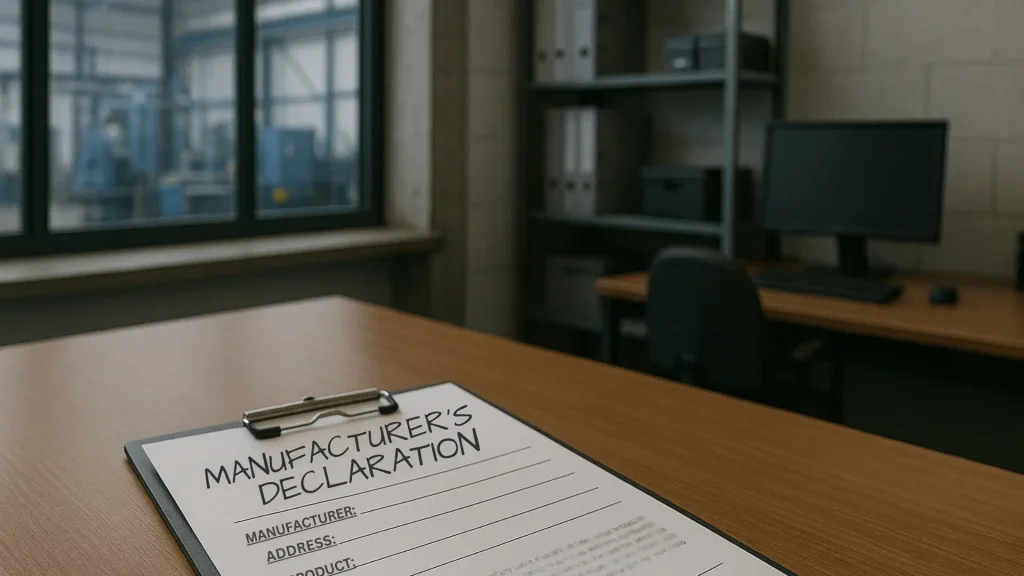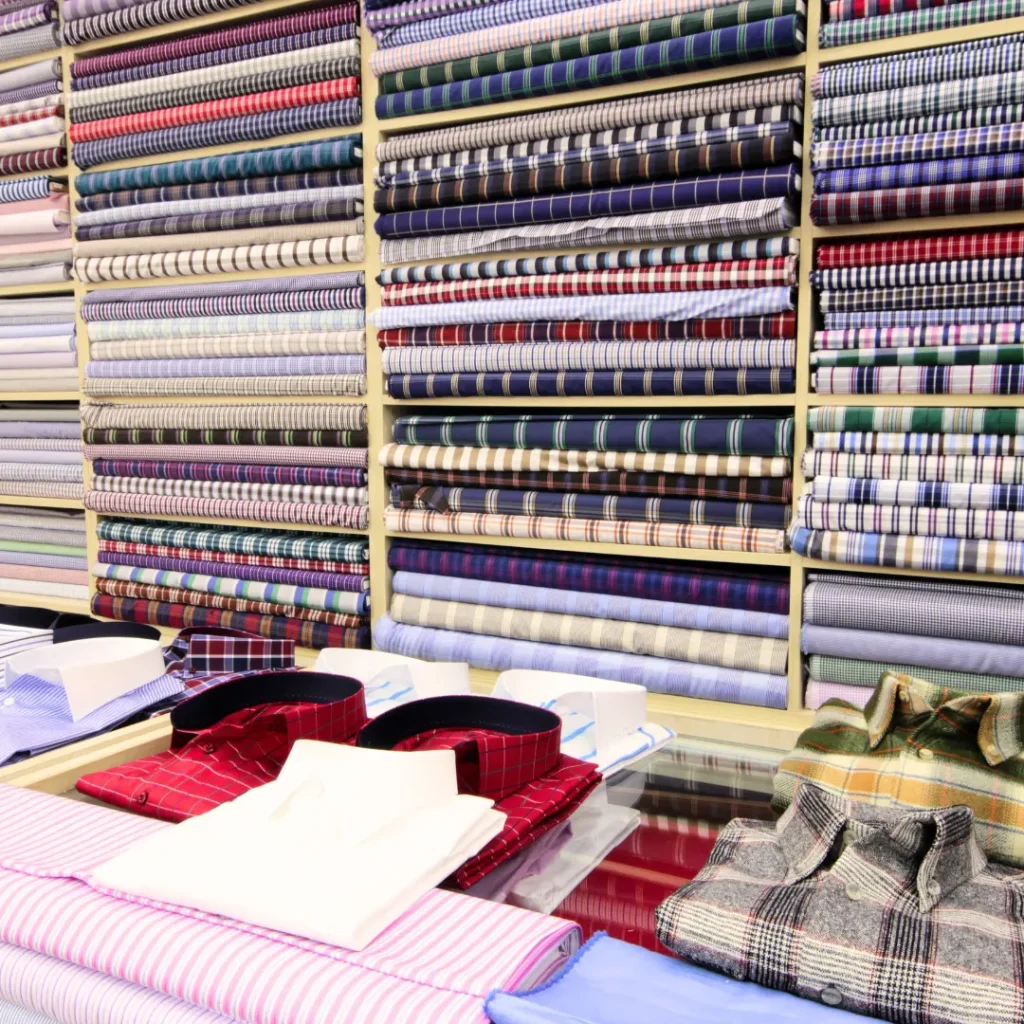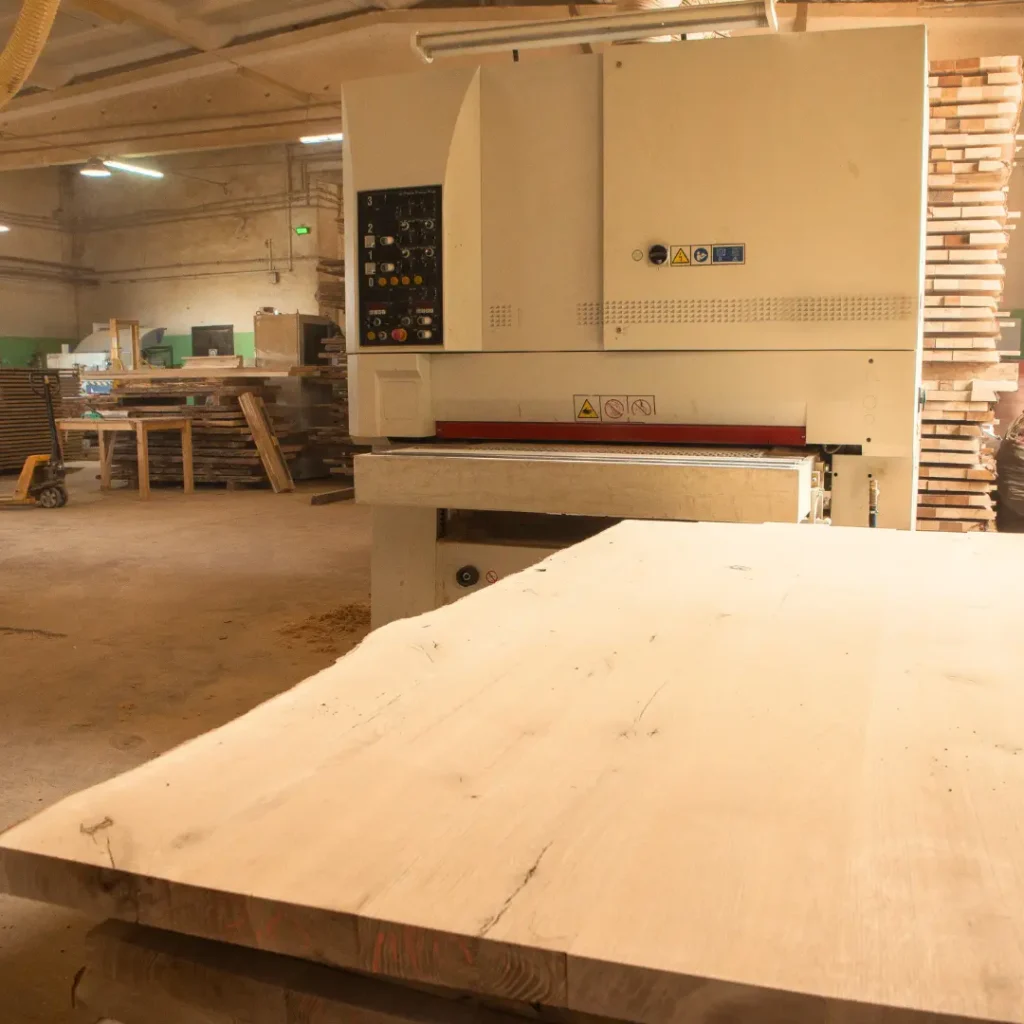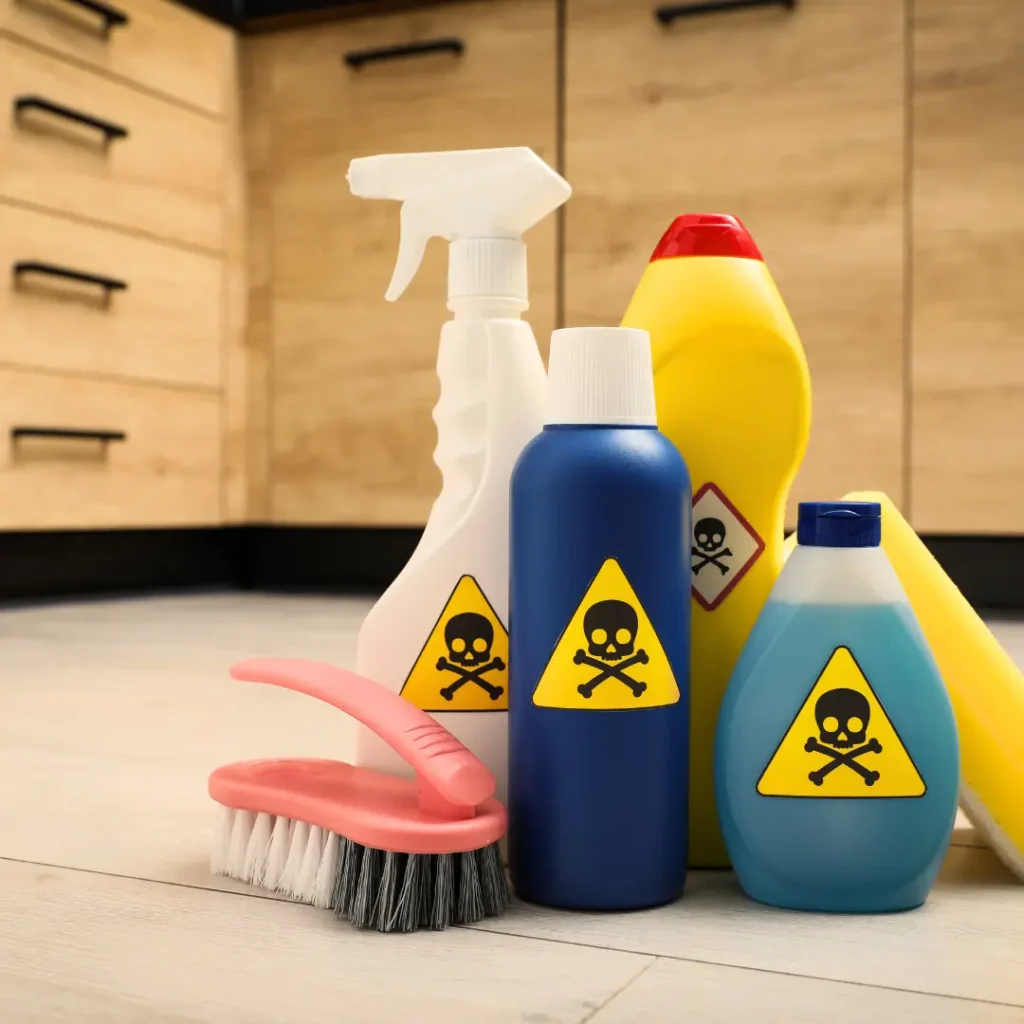As an Australian business involved in global supply chain, you’re likely to encounter various regulatory requirements when importing or exporting goods. One crucial document that can facilitate smooth trade, provide supply chain transparency, and aid in customs processes is the Manufacturer’s Declaration. This article will explore what a Manufacturer’s Declaration is, its significance for Australian businesses, and how it interacts with Australian regulations. We aim to provide a comprehensive guide that surpasses existing resources in clarity, detail, and practical application for Australian businesses.
What is a Manufacturer's Declaration?
A Manufacturer’s Declaration is a formal document issued by the manufacturer or their authorised representative that provides key information about a product. For example its identity (name, model, specifications), origin (country of manufacture), manufacturing details (materials, processes), and sometimes, attestation to compliance with relevant manufacturing standards. This document serves as a foundational element in international trade, offering essential details about the product’s identity, origin, and manufacturing process.
Purpose
The primary purposes of a Manufacturer’s Declaration are to:
- Firstly, provide essential product information for customs clearance in Australia and destination countries.
- Secondly, establish the country of origin for tariff classification, preferential tariff treatment under Australia’s Free Trade Agreements (FTAs). And to determine if trade remedies like anti-dumping duties apply.
- Thirdly, offer transparency regarding the product’s manufacturing and composition, including any specific processes.
- Moreover, support compliance with various regulatory requirements. Although it is not typically a direct attestation of conformity to specific Australian standards (that’s usually the role of the Australian Declaration of Conformity).
- Lastly, communicate product information to the importer/buyer.

When is a Manufacturer's Declaration Required?
A Manufacturer’s Declaration is not a mandatory document for all imports and exports to or from Australia. Its necessity depends on specific circumstances, including:
- Free Trade Agreements (FTAs). Firstly, when claiming preferential tariff treatment under an FTA. So a Manufacturer’s Declaration (or a similar origin declaration) may be required to prove the goods meet the agreement’s rules of origin.
- Customs Requirements. Moreover, The Australian Border Force (ABF) may request a Manufacturer’s Declaration or similar documentation to verify the origin, composition. Or it could be requested for other details of goods for customs valuation, tariff classification, or compliance purposes.
- Specific Industry Regulations. Furthermore, certain industries or types of goods may have specific requirements for documentation that resemble or include the information found in a Manufacturer’s Declaration.
- Importer Requests. Finally, Australian importers may request a Manufacturer’s Declaration from their suppliers as part of their due diligence process. For example for quality control, or to meet their own internal compliance requirements.
It’s important to note that while not always mandatory, providing a Manufacturer’s Declaration can often facilitate smoother trade and reduce the risk of delays or inquiries from authorities.
Which Authorities May Request a Manufacturer's Declaration?
The following authorities may request a Manufacturer’s Declaration or similar documentation:
- Australian Border Force (ABF). Generally, the ABF is the primary authority responsible for customs controls. So they may request the declaration to verify origin, tariff classification, and compliance with import/export regulations.
- Department of Agriculture, Fisheries and Forestry (DAFF). Additionally, DAFF may require information about the origin and treatment of certain goods (e.g., timber) to ensure compliance with Australia’s biosecurity requirements.
- Other Regulatory Bodies. Moreover, depending on the specific goods, other Australian regulatory bodies (e.g., the Therapeutic Goods Administration (TGA) for medical devices, the Australian Communications and Media Authority (ACMA) for telecommunications equipment) may require documentation that includes information typically found in a Manufacturer’s Declaration.
Difference between a Manufacturers Declaration and a Declaration of Conformity
At its core, a Manufacturer’s Declaration is sometimes referred to as a Declaration of Conformity in certain contexts; however, they are not always interchangeable.
Although both a Manufacturer’s Declaration and a Declaration of Conformity are issued by the manufacturer and provide details about the product, they serve different purposes.
- Manufacturer’s Declaration: This document primarily focuses on the product’s origin, manufacturing details, and general characteristics. Moreover, it is often used for customs clearance, trade agreements, and supply chain transparency in Australia.
It confirms what the product is and how it was made. Additionally, it supports the movement of goods without necessarily confirming compliance with mandatory standards. - Declaration of Conformity (DoC): This is a legal document where the manufacturer or supplier declares that a product complies with specific Australian safety, health, and environmental regulations. Furthermore, it is required under various Australian laws for products like electrical equipment, machinery, and medical devices.
It demonstrates that the product meets the required Australian standards; in essence, it confirms that the product is safe and compliant for sale and use in Australia.
Why is a Manufacturer's Declaration Important for Australian Businesses?
A Manufacturer’s Declaration is important for several reasons.
- Facilitating Customs Clearance
Firstly, an accurate declaration provides essential information. The Australian Border Force (ABF) requires this information for efficient processing of imports and exports. Consequently, it reduces delays, inspections, and costs.
- Ensuring Compliance
Secondly, it ensures compliance with Tariff and Trade Agreements. The declaration of origin is critical. In other words, the declaration of origin is critical for Australian importers to claim preferential tariff rates under Australia’s FTAs with various countries. Similarly, for Australian exporters, it provides necessary information for their overseas buyers to benefit from such agreements. It also helps determine if the goods are subject to any trade remedies.
- Enabling Supply Chain Transparency and Traceability
Thirdly, this document allows Australian businesses to gain a better understanding of their supply chain. Also it helps to know where their goods originate, and has a record of the manufacturing process. Which can be vital for quality control, risk management, and ethical sourcing.
- Supporting Biosecurity Measures
Moreover, for certain goods, the Manufacturer’s Declaration might include information about materials or treatments, such as timber. As a result this information is relevant to Australia’s strict biosecurity requirements, helping to prevent the introduction of pests and diseases.
- Laying the Groundwork for Other Compliance Documents
Additionally, the information in a Manufacturer’s Declaration often forms the basis for other compliance documents that might be required for Australia. For instance the Australian Declaration of Conformity (AoC) for regulated goods.
- Providing Product Information
Finally, the declaration communicates vital information about the product from the manufacturer to the importer/buyer.
What Products Might Require a Manufacturer's Declaration for Australian Trade?
While Australian regulations do not provide a single, comprehensive list, some products still require a Manufacturer’s Declaration. Moreover, it is important to understand that this document is frequently a standard requirement requested by Australian importers.
In addition, it is often part of the broader documentation process for various types of goods.
The specific need for a Manufacturer’s Declaration often depends on a combination of factors, including:
- The nature of the goods themselves.
- The specific import or export regulations that apply.
- The requirements of any relevant Free Trade Agreements.
- The importer’s own due diligence procedures.
Here are some examples of the types of products where a Declaration is commonly used:
• Goods Subject to Origin Rules in FTAs
As mentioned earlier, when businesses seek to claim preferential tariff treatment under Australia’s Free Trade Agreements (FTAs), a Manufacturer’s Declaration (or a similar document focused on origin) is often essential. These agreements have specific “rules of origin”. That dictate the criteria a product must meet to be considered as originating from a participating country.
• Agricultural and Food Products
For certain agricultural and food products, detailed information about their origin and processing methods may be required.
Additionally, information about constituent materials may be necessary to comply with Australia’s biosecurity and food safety regulations. These regulations aim to protect Australia’s agricultural sector and public health.

• Textiles and Apparel

Declarations of origin and material composition are frequently needed for textiles and apparel products. So these declarations help ensure compliance with customs regulations, labeling requirements, and potential trade restrictions.
• Machinery and Industrial Equipment
When importing or exporting machinery and industrial equipment, details about their manufacturing and origin can be relevant for various purposes. These purposes include assessing compliance with safety standards, determining the correct customs classification, and providing information for end-users.

• Automotive Parts

In the automotive industry, information about the origin and manufacturing details of parts is often required for customs purposes. Additionally, if the manufacturer is also supplying parts for use in vehicles sold in Australia, these details may be relevant for demonstrating compliance with Australian Design Rules (ADRs). So these rules set safety and performance standards for vehicles.
• Timber and Wood Products
Given Australia’s strict biosecurity measures, declarations regarding the treatment and origin of timber products are crucial. Moreover, compliance with standards such as ISPM 15 for timber packaging is often specifically required. Consequently, these declarations help prevent the introduction of timber-borne pests and diseases.

• Chemicals

Lastly, for the import or export of chemicals, detailed information on their chemical composition and the manufacturing process is often necessary. This information can be also crucial for compliance with regulations related to safety, handling, and environmental protection.
Important Note: Given the complexities of international trade and the potential for regulations to change, it is absolutely crucial for Australian businesses to verify the specific import or export requirements for their particular goods. Moreover, this verification should be done in consultation with the Australian Border Force (ABF), any other relevant regulatory bodies, or an experienced freight forwarder to ensure full compliance.
How to Obtain a Manufacturer's Declaration
Obtaining a Manufacturer’s Declaration is a crucial step for Australian businesses involved in importing goods. This process ensures you have the necessary documentation for customs clearance, compliance with regulations, and smooth trade operations. Here’s a step-by-step guide for Australian businesses:
- Identify the Need. The first step is to determine whether a Manufacturer’s Declaration is required or beneficial for your specific goods.
- This determination should be based on several factors, including:
- Australian customs regulations
- Applicable trade agreements
- Your own internal due diligence processes
- This determination should be based on several factors, including:
- Communicate Clearly with the Manufacturer.
Secondly, once you’ve established the need for a Manufacturer’s Declaration, communicate clearly with your overseas supplier.
- When requesting the declaration, be sure to:
- Specify all the necessary information, such as product details, origin, and materials.
- Inquire about any specific format requirements, although Australia doesn’t mandate a particular format.
- Verify the Information.
Thirdly, upon receiving the Manufacturer’s Declaration, it’s essential to review it carefully.
- Ensure that all the information is accurate and complete.
- Pay close attention to details such as:
- Product descriptions
- Country of origin
- Manufacturer details
- Remember that discrepancies can lead to delays or issues with Australian customs.
- Maintain Records.
Additionally, proper record-keeping is vital in international trade.
- Keep the Manufacturer’s Declaration readily accessible as part of your shipping documentation.
- This will help you respond quickly to any inquiries from Australian customs or other authorities.
- Provide a Template.
Finally, to streamline the process and ensure you receive all the required information, provide a template to your manufacturer.
- A template can help prevent misunderstandings and ensure consistency in the declarations you receive.
Manufacturer Declaration Letter Sample
To help Australian businesses understand the structure and content of a Manufacturer’s Declaration, we provide a sample template below:
Example:
Below is an example of a Manufacturer’s Declaration from a Chinese manufacturer:
[HealWell Medical Co., Ltd. 18 Prosperity Way, Shenzhen, Guangdong, China 518000 Tax ID: 987-654-3210]
Date: 2025-07-28
To: [SafeCare Medical Supplies Pty Ltd 14 Excellence Drive, Melbourne, VIC 3000 Australia]
Subject: Manufacturer’s Declaration for “NeurologikPulse 3000” Medical Device, Shipment Details: Invoice # INV-2025-07-1234, Container # CNTR-1234567
We, HealWell Medical Co., Ltd., located at 18 Prosperity Way, Shenzhen, Guangdong, China, hereby declare that the goods described below:
- Product Name: NeurologikPulse 3000
- Model Number: HA-NZ-3000
- Quantity: 10 Units
- Detailed Description: The NeurologikPulse 3000 is a non-invasive medical device designed for neurological stimulation. It includes a central processing unit, a handheld applicator, and associated cables. Specifications: Input Voltage: 100-240V, Output Frequency: 1-100 Hz, Pulse Width: 50-500 μs.
- Country of Origin: China
- Materials Used (if relevant for regulations or biosecurity): Main housing: ABS Plastic, Applicator: Polycarbonate, Cables: PVC.
- Manufacturing Processes (briefly, if relevant): Injection molding, electronic component assembly, final product testing and calibration.
- Packaging Details (if relevant for biosecurity): Each unit is packaged in a cardboard box with foam inserts. The cardboard packaging is untreated.
We further declare that the information provided in this declaration is true and accurate to the best of our knowledge.
[Optional: Statement Regarding Adherence to Manufacturing Standards – e.g., “These goods were manufactured according to Relevant ISO Standard principles.”]
Sincerely,
[Eleanor Vance]
[Quality Assurance Manager]
[+86 755 1234 5678]
Disclaimer: The Manufacturer’s Declaration example provided above pertains to a fictional manufacturer of medical products. All company and product names, addresses, and other details are entirely fictitious and for illustrative purposes only. Any resemblance to actual companies, products, or information is purely coincidental.
Australian-Specific Requirements and Regulations

Australian businesses involved in global trade must navigate a unique set of regulations. Here’s how the Manufacturer’s Declaration intersects with some key Australian legislation:
While the Manufacturer’s Declaration isn’t a direct compliance document for the ACL, it plays a supporting role. Generally, the information it contains about a product’s specifications, origin, and materials can be relevant if issues of product quality, safety, or false representation arise. So accurate manufacturing details contribute to overall product transparency and can be used as evidence in matters relating to product liability and consumer guarantees.
For electrical goods imported into Australia, a Manufacturer’s Declaration detailing the product’s specifications and the manufacturing standards it adheres to can be provided. Generally this document supports the supplier’s (often the importer) responsibility to obtain an Australian Declaration of Conformity (AoC).The AoC demonstrates compliance with EESS. In this context, the Manufacturer’s Declaration provides foundational information.
Additionally, the TGA has stringent requirements for medical devices and therapeutic goods. A Manufacturer’s Declaration, which details the device’s specifications, manufacturing processes, and origin, is a crucial part of the overall compliance framework that importers must adhere to. Also it’s important to note that the TGA emphasises the Australian sponsor’s (importer’s) responsibility to ensure goods meet Australian standards.
Moreover, for goods that pose a biosecurity risk (e.g., timber, agricultural products), the Manufacturer’s Declaration may need to include specific information about treatment, origin of materials, and processing. Generally, this information helps to meet Australia’s import conditions and prevent the introduction of pests and diseases. The Department of Agriculture, Fisheries and Forestry (DAFF) sets these requirements.
Customs Act 1901 and related regulations
Finally, the Australian Border Force (ABF) uses the Manufacturer’s Declaration to verify the origin of goods. This verification is essential for tariff classification, administering preferential trade agreements, and preventing dumping or the import of prohibited goods. So accurate origin information is therefore paramount.
Conclusion:
In conclusion, a Manufacturer’s Declaration is a vital document for Australian businesses engaged in global shipping. By understanding its purpose, the information it contains, and its role in the context of Australian regulations, businesses can navigate international trade more effectively, ensure compliance, mitigate risks, and foster smoother relationships with both international suppliers and Australian regulatory authorities.
Get Expert Help with Logistics and Customs Clearance
If you have any questions, need professional advice, or help with handling the logistics of your goods and customs clearance, feel free to contact GenFreight. Our team of experts is here to support your business and help you navigate the complexities of global trade.
Disclaimer
The information contained in this article is for general informational purposes only and is not intended to be a comprehensive or definitive guide. While every effort has been made to ensure the accuracy and reliability of the information, GenFreight and its affiliates disclaim any liability for any errors, omissions, or inaccuracies.
